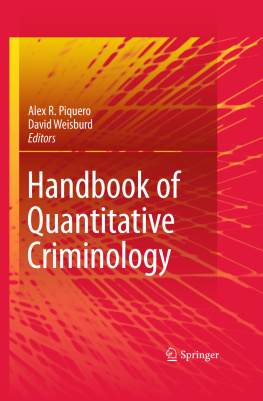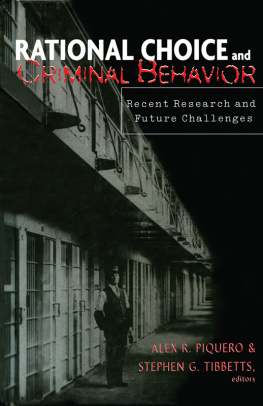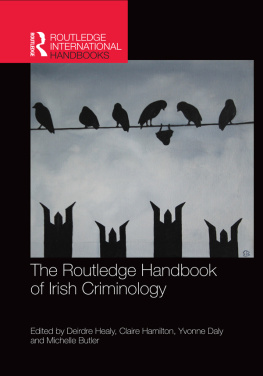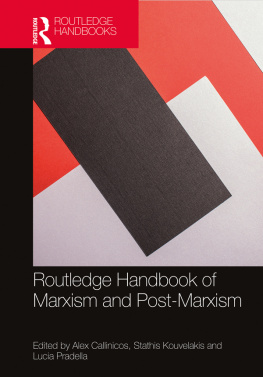Part 1
Descriptive Approaches for Research and Policy: Innovative Descriptive Methods for Crime and Justice Problems
Alex R. Piquero and David Weisburd (eds.) Handbook of Quantitative Criminology 10.1007/978-0-387-77650-7_1 Springer Science+Business Media, LLC 2010
1. Introduction
Alex R. Piquero 1 and David Weisburd 2, 3
(1)
Florida State University, College of Criminology and Criminal Justice Hecht House, 634 W. Call Street, Tallahassee, Florida
(2)
Administration of Justice, George Mason University, Manassas, VA, USA
(3)
Institute of Criminology, Hebrew University of Jerusalem, Jerusalem, Israel
Abstract
Quantitative methods are at the heart of social science research generally, and in criminology/criminal justice in particular. Since the disciplines birth, researchers have employed a variety of quantitative methods to describe the origins, patterning, and response to crime and criminal activity, and this line of research has generated important descriptive information that has formed the basis for many criminological/criminal justice theories and public policies. And in the past quarter-century, the advent and expansion of computers and advanced software applications has led to a burgeoning of methodological and statistical tools that have been put to use to address many criminological/criminal justice research issues. In short, the field of quantitative criminology now routinely employs quantitative techniques of all levels of complexity, not only to deal with the advances in longitudinal, experimental, and multilevel data structures but also to study substantive methodological or evaluative concerns of interest in the criminological/criminal justice community.
Unfortunately, many of the quantitative methods used in criminology/criminal justice have tended to appear in journal articles and book chapters such that a handbook-oriented reference guide has not existed that contains, in one volume, many of the important contemporary quantitative methods employed in criminology/criminal justice, especially those that have been developed to study difficult criminological questions, which have been previously examined using limited and/or inappropriate methodologies applied to particular types of data structures.
Quantitative methods are at the heart of social science research generally, and in criminology/criminal justice in particular. Since the disciplines birth, researchers have employed a variety of quantitative methods to describe the origins, patterning, and response to crime and criminal activity, and this line of research has generated important descriptive information that has formed the basis for many criminological/criminal justice theories and public policies. And in the past quarter-century, the advent and expansion of computers and advanced software applications has led to a burgeoning of methodological and statistical tools that have been put to use to address many criminological/criminal justice research issues. In short, the field of quantitative criminology now routinely employs quantitative techniques of all levels of complexity, not only to deal with the advances in longitudinal, experimental, and multilevel data structures but also to study substantive methodological or evaluative concerns of interest in the criminological/criminal justice community.
Unfortunately, many of the quantitative methods used in criminology/criminal justice have tended to appear in journal articles and book chapters such that a handbook-oriented reference guide has not existed that contains, in one volume, many of the important contemporary quantitative methods employed in criminology/criminal justice, especially those that have been developed to study difficult criminological questions, which have been previously examined using limited and/or inappropriate methodologies applied to particular types of data structures.
As a result, we reached out to leading quantitative researchers to develop chapters on many of the important methodological and statistical techniques used by criminologists to study crime and the criminal justice system. As such, The Handbook of Quantitative Criminology is designed to be the authoritative volume on methodological and statistical issues in the field of criminology and criminal justice.
Like handbooks available in other disciplines (economics, psychology, sociology), this book is designed to be a reference for new and advanced methods in criminology/criminal justice that provide overviews of the issues, with examples and figures as warranted, for students, faculty, and researchers alike. Authored by leading scholars in criminology/criminal justice, the handbook contains 35 chapters on topics in the following areas that have served witness to a proliferation of data collection and subsequent empirical research: (1) Innovative Descriptive Methods for Crime and Justice Problems; (2) New Estimation Techniques for Assessing Crime and Justice Policy; (3) New Directions in Assessing Design, Measurement and Data Quality; (4) Topics in Experimental Methods; (5) Innovation in Quasi-Experimental Design; and (6) Nonexperimental Approaches to Explaining Crime and Justice Outcomes. And although there exists many other methodological and quantitative techniques and issues in the study of criminology/criminal justice, the coverage of which would have been too difficult to include in a single handbook, the Handbook of Quantitative Criminology is intended to provide readers with a useful resource containing a comprehensive and contemporary treatment of research methodologies used in criminology/criminal justice.
We are honored to have this impressive list of contributors who have taken time out of their busy schedules and have worked carefully to construct entries in such a manner that they are as widely accessible as possible to readers of all levels, especially those who are seeking to learn the basic issues surrounding key methodological and quantitative methods. In this regard, we asked the chapter authors to follow as common a format as possible to be illustrative and to help guide readers of all levels of experience. We hope that readers learn as much about these methods and issues as we have.
Alex R. Piquero and David Weisburd (eds.) Handbook of Quantitative Criminology 10.1007/978-0-387-77650-7_2 Springer Science+Business Media, LLC 2010
2. Crime Mapping: Spatial and Temporal Challenges
Jerry Ratcliffe 1
(1)
Department of Criminal Justice, Temple University, Philadelphia, PA, USA
Abstract
Crime opportunities are neither uniformly nor randomly organized in space and time. As a result, crime mappers can unlock these spatial patterns and strive for a better theoretical understanding of the role of geography and opportunity, as well as enabling practical crime prevention solutions that are tailored to specific places. The evolution of crime mapping has heralded a new era in spatial criminology, and a re-emergence of the importance of place as one of the cornerstones essential to an understanding of crime and criminality. While early criminological inquiry in France and Britain had a spatial component, much of mainstream criminology for the last century has labored to explain criminality from a dispositional perspective, trying to explain why a particular offender or group has a propensity to commit crime. This traditional perspective resulted in criminologists focusing on individuals or on communities where the community extended from the neighborhood to larger aggregations (Weisburd et al. ). Even when the results lacked ambiguity, the findings often lacked policy relevance. However, crime mapping has revived interest and reshaped many criminologists appreciation for the importance of local geography as a determinant of crime that may be as important as criminal motivation. Between the individual and large urban areas (such as cities and regions) lies a spatial scale where crime varies considerably and does so at a frame of reference that is often amenable to localized crime prevention techniques. For example, without the opportunity afforded by enabling environmental weaknesses, such as poorly lit streets, lack of protective surveillance, or obvious victims (such as overtly wealthy tourists or unsecured vehicles), many offenders would not be as encouraged to commit crime.






